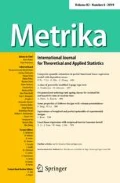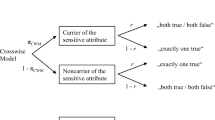Abstract
In the present investigation, a new forced quantitative randomized response (FQRR) model has been proposed. Both situations when the values of the forced quantitative response are known and unknown are studied. The forced qualitative randomized response models due to Liu and Chow (J Am Stat Assoc 71:72–73, 1976a, Biometrics 32:607–618, 1976b) and Stem and Steinhorst (J Am Stat Assoc 79:555–564, 1984) are shown as a special case of the situation when the value of the forced quantitative randomized response is simply replaced by a forced “yes” response. The proposed FQRR model remains more efficient than the recent Bar-Lev et al. (Metrika, 60:255–260, 2004), say BBB model. The relative efficiency of the proposed FQRR model with respect to the existing competitors, like the BBB model, has been investigated under different situations. No doubt the present model will lead to several new developments in the field of randomized response sampling. The proposed FQRR model will encourage researchers/scientists to think more on these lines.
Similar content being viewed by others
References
Bar-Lev SK, Bobovitch E, Boukai B (2004) A note on randomized response models for quantitative data. Metrika 60:255–260
Bhargava M (1996) An investigation into the efficiencies of certain randomized response strategies. Unpublished Ph.D. Thesis submitted to Punjab Agricultural University, Ludhiana
Bhargava M, Singh R (2001) Efficiency comparison of certain randomized response schemes with U-model. J Indian Soc Agric Stat 54(1):19–28
Bhargava M, Singh R (2002) On the efficiency comparison of certain randomized response strategies. Metrika 55(3):191–197
Cochran WG (1977) Sampling techniques, 3rd edn. Wiley, New York
Eichhorn BH, Hayre LS (1983) Scrambled randomized response methods for obtaining sensitive quantitative data. J Stat Plan Infer 7:307–316
Fox JA, Tracy PE (1986) Randomized response: a method for sensitive surveys. SAGE Publications, London
Gjestvang CR, Singh S (2006) A new randomized response model. J R Stat Soc B 68:523–530
Kuk AYC (1990) Asking sensitive questions indirectly. Biometrika 77:436–438
Lanke J (1975) On the choice of the unrelated question in Simons version of randomised response. J Am Stat Assoc 70:80–83
Lanke J (1976). On the degree of protection in randomized interviews. Int Stat Rev 44:197–203
Leysieffer FW, Warner SL (1976) Respondent jeopardy and optimal designs in randomized response models. J Am Stat Assoc 71:649–656.h
Liu PT, Chow LP (1976a). A new discrete quantitative randomized response model. J Am Stat Assoc 71:72–73
Liu PT, Chow LP (1976b) The efficiency of the multiple trial randomized response technique. Biometrics 32:607–618
Mangat NS (1994) An improved randomized response strategy. J R Stat Soc B 56:93–95
Mangat NS, Singh R (1990) An alternative randomized response procedure. Biometrika 77(2):439–442
Moors JJA (1997) A critical evaluation of Mangat’s two-step procedure in randomized response. Discussion paper at Center for Economic Research. Tilburg University, The Netherlands
Nayak TK (1994) On randomized response surveys for estimating a proportion. Commun Stat Theory Methods 23(1):3303–3321
Singh S (2003) Advanced sampling theory with applications: how Michael “Selected” Amy. Kluwer, The Netherlands
Stem DE, Steinhorst RK (1984) Telephone interview and mail questionnaire applications of the randomized response model. J Am Stat Assoc 79:555–564
Tracy DS, Mangat NS (1996) Some developments in randomized response sampling during the last decade – A follow up of review by Chaudhuri and Mukerjee. J Appl Stat Sci 4(2/3):147–158
Warner SL (1965) Randomized response: a survey technique for eliminating evasive answer bias. J Am Stat Assoc 60:63–69
Zou G (1997) Two-stage randomized response procedures as single stage procedures. Aust J Stat 39:235–236
Author information
Authors and Affiliations
Corresponding author
Rights and permissions
About this article
Cite this article
Gjestvang, C.R., Singh, S. Forced quantitative randomized response model: a new device. Metrika 66, 243–257 (2007). https://doi.org/10.1007/s00184-006-0108-1
Received:
Published:
Issue Date:
DOI: https://doi.org/10.1007/s00184-006-0108-1




